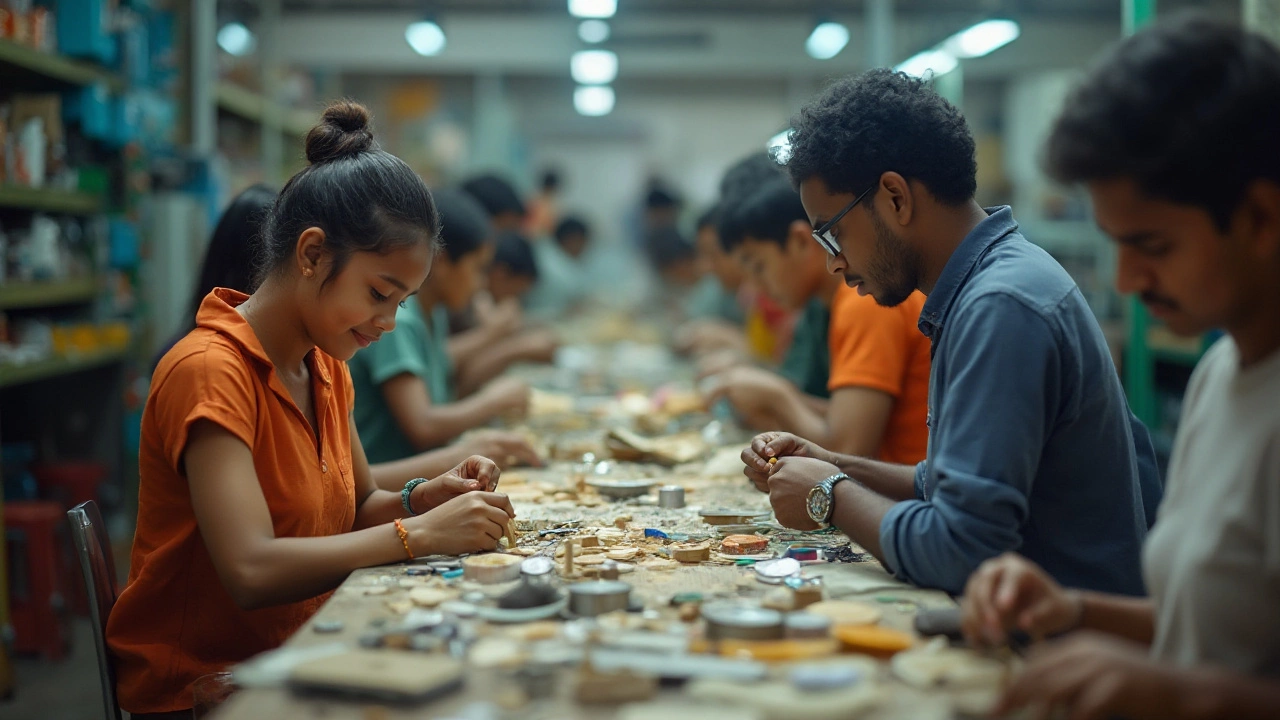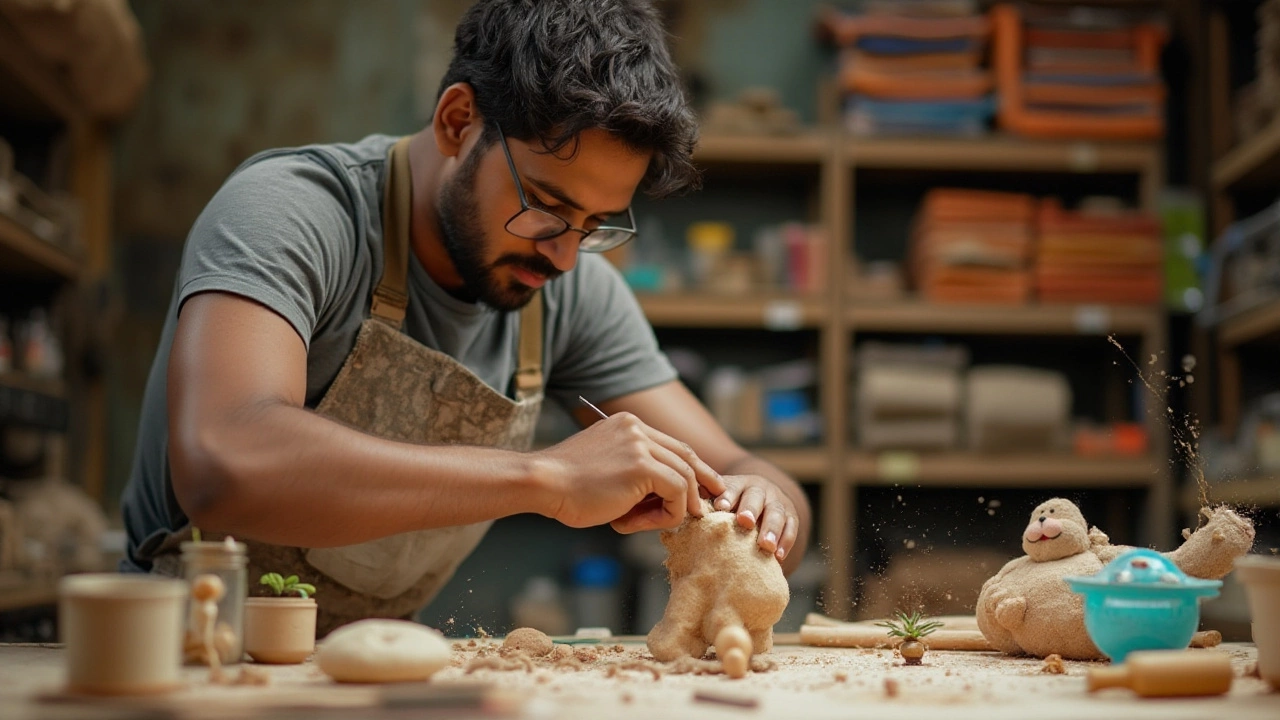 Jan, 19 2025
Jan, 19 2025
The world of small scale manufacturing is not just churning gears and humming with productivity; it's teeming with innovation, sustainability, and endless opportunities. In 2025, a few sectors are leading the charge and redefining what success looks like in this industry.
As consumer preferences shift towards eco-friendliness, manufacturers are keen on producing sustainable goods without compromising on quality. This move caters to a growing demand among environmentally-conscious buyers, creating a major ripple effect across industries.
Technology-driven innovations are another driving force. From personalized tech gadgets to smart home devices, small manufacturers are at the forefront of creating high-demand products that blend utility with modernity.
In addition, craftsmanship is making a strong comeback with a focus on customization. This trend is allowing smaller companies to offer unique, tailor-made products that cater to niche markets.
While the landscape is promising, challenges remain. Navigating market fluctuations, securing resources, and maintaining quality are critical factors manufacturers need to manage as they ride this wave of prosperity.
- Rise of Eco-friendly Products
- Technology-driven Innovations
- Craftsmanship and Customization
- Navigating Market Challenges
Rise of Eco-friendly Products
The surge in demand for eco-friendly products is reshaping the landscape of small scale manufacturing. As the world grapples with climate change and environmental degradation, consumers are becoming more aware of their carbon footprint. This awareness is fueling a shift toward sustainable living, and manufacturers are tapping into this trend by offering products that are not only gentle on the planet but are also efficient and innovative. Packaging materials made from recycled content, biodegradable items, and products crafted from sustainably sourced ingredients are leading the charge. This trend isn’t just a market response; it's rapidly becoming a new norm, as people strive to reduce waste and promote a greener future.
One remarkable aspect of this movement is the creativity that small manufacturers are displaying in their pursuit of sustainability. From creating household cleaning products with non-toxic ingredients to developing fashion pieces using organic fibers, the possibilities are expansive. In many cases, what used to be considered waste material is now carefully processed and transformed into new, valuable items. Manufacturers are also keen on integrating new technologies such as solar power in factories, which solidifies their commitment to lowering emissions and reliance on fossil fuels. Their innovative solutions are effectively bridging the gap between profitability and environmental responsibility.
The transition isn't without its hurdles, as finding eco-friendly raw materials at competitive prices can be a challenge. Moreover, educating consumers about the benefits of sustainable products requires substantial effort and a strategic marketing approach. Studies show that consumers are willing to spend up to 20% more on sustainable goods, yet only if they're convinced of the tangible benefits. It's encouraging to see various initiatives and government policies supporting this transition, offering tax incentives, subsidies, or certification programs to businesses championing green products. These advantages can make all the difference for small manufacturers striving to capture market share.
Importantly, collaboration plays a crucial role in this sector. In a recent interview with Lisa Jackson, Apple's Vice President of Environment, Policy, and Social Initiatives, she stated, "The collaboration between industries and consumers is essential to drive continuous change. It's about creating a systemic shift, one that both meets ecological goals and propels business growth."
Such insights provide clear evidence that collective action and communication are crucial in encouraging the adoption of eco-friendly practices.
As the small scale manufacturing industry navigates this green revolution, it's clear that speed and innovation will shape the future. The adaptability and resilience of small businesses are proving to be their strongest assets. Embracing sustainable practices, they are not only fulfilling consumer demand but are also contributing significantly to the fight against climate change. In urban and rural settings alike, these small players are making a big impact by reinventing traditional production processes and leading a charge towards a sustainable tomorrow.

Technology-driven Innovations
The landscape of small scale manufacturing today is being dramatically reshaped by a wave of technology-driven innovations. Imagine a workshop not as a maze of archaic machines, but as a tech-savvy hub bustling with cutting-edge gadgets creating wonders day in, day out. It's not a scene from the future; it’s happening now in 2025. This trend is bringing about remarkable changes in functionality and design, carving new pathways for businesses to intercept evolving consumer demands.
Much of this development can be attributed to advancements in 3D printing technology, which is revolutionizing how products are conceptualized and manufactured. Companies are harnessing this capability to offer personalized goods at a speed and cost unimaginable a decade ago. It's not just about speed or cost, though—it's harnessing creativity into tangible products that meet specific consumer needs. This personalized touch is becoming increasingly significant, as customer satisfaction hinges not just on quality, but on a product's ability to cater to individual preferences.
The world witnessed a quantum leap with the advent of smart materials—substances that respond dynamically to environmental changes—and their integration into small scale manufacturing. These materials make it simpler to produce items that adjust their properties in real time, opening an array of functional possibilities, especially in areas like tech gadgets and smart home devices, which are seeing an unprecedented demand surge. Consumers are no longer passive users; they interact and engage with their products, enhancing their everyday experience.
According to Forbes, "The reach of smart manufacturing is expanding globally, creating a more interactive space for user-focused production methodologies."
Artificial intelligence (AI) and machine learning (ML) are also significant contributors to this evolution. Manufacturers leverage these innovations to improve efficiency and reduce waste, transforming traditional operations into sleek, optimized systems welcoming AI oversight. This not only increases production accuracy but also aids in decision-making processes, revolutionizing both the 'what' and 'how' of small scale manufacturing. In terms of business opportunity, AI opens doors to venture into the creation of groundbreaking products with minimal human intervention.
There is an interesting revelation—an increase in small scale tech gadget companies rising swiftly. These enterprises are not massive corporations; instead, they are nimble start-ups taking advantage of gaps in the market. They exist in a tier where ambitious ideas can flourish, creating unique tech gadgets catering to niche markets. By focusing on fewer resources with intense innovation, these companies turn lean operations into thriving business models effectively competing with giants. Emphasizing innovation, agility, and customer-centric approaches, these fledgling enterprises often set trends instead of following them.
As we delve deeper into the essence of today's small scale manufacturing, the presence and impact of the Internet of Things (IoT) can't be ignored. With interconnected devices becoming prevalent household fixtures, small manufacturers see plenty of opportunity to innovate within this realm. IoT creates a seamless interaction layer between devices, promising a connected future. Entrepreneurs in this space are dedicating resources to develop IoT-compatible products that amplify convenience, security, and overall lifestyle.
Thriving industries in 2025 are being nurtured by these tech-driven innovations, shaping new customer habits and rewriting the rules of commerce. Manufacturers and entrepreneurs are quickly adapting, anchoring their strategies on these promising technologies to ride this exciting wave into the future of small scale manufacturing.

Craftsmanship and Customization
In recent years, the allure of craftsmanship and customization has revived interest in small scale manufacturing. This sector thrives on the art of making unique, personalized products that cater to individual preferences, standing in stark contrast to the mass-produced items that dominate the global market. Many consumers are looking for products that tell a story, those that are handwoven by skilled artisans, engineered to their exact needs, or tailored to fit their personal styles. As a result, manufacturers focusing on customization are gaining a competitive edge, harnessing the power of human creativity and individual expression to drive their success.
One of the most fascinating aspects of modern craftsmanship is its seamless integration with today's technology. Digital tools like 3D printing, CNC machinery, and design software have revolutionized the way bespoke items are created. These technologies allow for greater precision, faster production times, and the ability to experiment with new materials. They empower small businesses and entrepreneurs to experiment with bold ideas. Henry Morgan, a craftsman in New York, once said,
"The charm of handmade lies in its imperfections, yet technology allows us to enhance those imperfections into features of admiration."Such sentiments echo across the industry, as makers find themselves at the intersection of tradition and innovation.
For aspiring entrepreneurs, the market is ripe with opportunities. Platforms such as Etsy and Shopify have made it easier for artisans to reach global audiences, building brands that are both localized and internationally recognized. By leveraging these platforms, craftsmen can showcase their unique offerings and connect directly with a diverse customer base. A growing trend is personalized home decor, where customers can dictate every detail—from color schemes to material compositions. Not only does this meet the rising desire for customized solutions, but it also encourages an appreciation for the artistic process behind each piece.
Beyond aesthetic appeal, craftsmanship is increasingly appealing due to its sustainable nature. As customers become more environmentally conscious, they prefer products that are not just unique but also ethically made. Craftsmanship involves techniques that often rely on local resources and foster community employment. This local-centric approach minimizes carbon footprint and supports sustainable practices. Data from the Craft Council indicates that more than 60% of consumers consider sustainability a crucial factor in choosing handcrafted products. In this light, the craftsman’s role positions them as advocates for sustainable, ethical production methods.
Nevertheless, manufacturers within this niche must navigate challenges such as fluctuating demand and the high cost of materials. They are often reliant on scarce resources or skilled labor that may be difficult to find. Maintaining a balance between quality and scalability is key, as businesses scale their operations to meet growing demand without losing the personal touch that defines their work. Despite these hurdles, the sector’s growth is undeniable. Entrepreneurs keen on joining this wave would do well to focus on honing their craft while staying attuned to market dynamics. By doing so, they can carve out a niche that is both profitable and personally fulfilling.

Navigating Market Challenges
In the vibrant realm of small scale manufacturing, businesses often find themselves in a dance between creativity and practicality. Despite the thriving market opportunities, navigating the labyrinthine challenges is no mean feat. One of the primary hurdles is adapting to fluctuating consumer trends which can shift unexpectedly, leaving manufacturers with surplus or dated products. This unpredictable demand requires businesses to remain flexible and responsive, constantly revisiting their production strategies. With the rapid pace of technological advancements, manufacturers also face the dilemma of deciding when to incorporate new technologies that might streamline production but require significant investments upfront.
Market volatility remains a formidable adversary as manufacturers navigate complex regulatory environments that may vary drastically from one region to another. These regulations can affect everything from materials used to the sustainability practices adhered to during production, demanding manufacturers keep abreast of legal changes and compliance requirements. According to the Small Business Administration, "many small manufacturers cite regulatory burden as a key barrier to growth," illustrating the widespread nature of this challenge. Supply chain disruptions are another unpredictable variable. Events such as natural disasters or geopolitical tensions can stall the availability of crucial components, which brings production to a grinding halt.
Quality control in small scale manufacturing is critical, especially when the aim is craftsmanship and customization. Manufacturers must ensure each product meets set standards, which requires rigorous quality checks that can strain resources, particularly for smaller teams. This challenge is compounded when scaling up operations due to increased volumes and more complex logistics. Additionally, there’s the task of competing with larger brands that benefit from economies of scale and established market presence. Small manufacturers must carve out niches, focusing on unique value propositions that differentiate them from their bigger counterparts. They often leverage their agility as an advantage, quickly responding to feedback and customizing offerings.
Another significant challenge is managing cash flow effectively. The financial health of a small manufacturing business can be precarious due to the capital-intensive nature of the industry. Ensuring a steady cycle of inputs and sales is crucial, where even slight misalignments can lead to significant financial strain. Manufacturers often develop strategic partnerships with suppliers or consider alternative funding, such as crowd-investing, to maintain liquidity. It’s essential for these businesses to also invest in research and development, keeping innovation at the forefront to retain consumer interest and competitive edge. Market intelligence plays a vital role, enabling businesses to anticipate trends and pivot strategies accordingly.
With 30% of small manufacturers reporting cyber threats as a growing concern, cybersecurity is increasingly becoming a focus area. Integrity of enterprise systems is paramount to protect sensitive production data and maintain business continuity. Manufacturers must invest in robust cybersecurity measures to safeguard against breaches and ensure the protection of intellectual property. It's a multifaceted challenge, interlinking with digital transformation efforts and the adoption of advanced manufacturing technologies. As industries evolve, utilizing data analytics and AI tools also becomes imperative, helping businesses optimize operations and predict market dynamics.